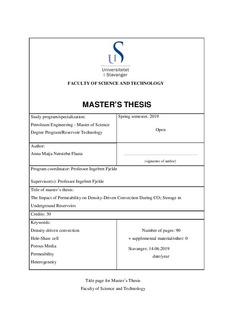| dc.contributor.advisor | Fjelde, Ingebret | |
| dc.contributor.author | Flaata, Anna Maija Nørstebø | |
| dc.date.accessioned | 2019-10-02T07:57:09Z | |
| dc.date.available | 2019-10-02T07:57:09Z | |
| dc.date.issued | 2019-06-14 | |
| dc.identifier.uri | http://hdl.handle.net/11250/2619764 | |
| dc.description | Master's thesis in Petroleum engineering | nb_NO |
| dc.description.abstract | Within the context of global warming, CO2 storage in geological reservoirs is seen as one of many strategies to reduce greenhouse gas emissions over the next few decades. In CO2 storage, the water density increases upon dissolution of CO2, leading to a density-driven convective flow regime, which accelerates the CO2 dissolution beyond that of molecular diffusion only. The aim of this thesis has been to visualize CO2 dissolution in water-saturated, water-wet porous media on an experimental scale, by varying the permeability conditions. This is to improve the understanding of the permeability impact on the CO2 dissolution on a reservoir scale.
This M.Sc. thesis is twofold; The literature part outlines how CO2 can be stored in reservoirs and the work that has previously been carried out on CO2 dissolution in the water phase in a reservoir, focusing on density-driven convection upon CO2 dissolution in water. The experimental part presents a set of Hele-Shaw experiments, conducted at 10 bars pressure and room temperature, in which CO2 dissolves in the water phase. The pH indicator method was used to visualize CO2 dissolution and a camera was used for documentation. Images and time-series data of finger lengths are presented. The experiments were repeated with various permeabilities to vary the characteristic Rayleigh number and variations in homogeneous and heterogeneous permeabilities.
Density-driven convection occurred in homogeneous permeability experiments with bulk water and high-permeable porous media. Experiments with homogeneous low-permeable porous media were, however, dominated by pure diffusion. In heterogeneous permeability experiments, a horizontal low-permeable layer in between high-permeable layers attenuated the density-driven convection, while density-driven convection occurred in a vertical high-permeable layer rather than in the low-permeable layers surrounding it.
As a continuation of the experimental work performed in the present study, I will suggest performing experiments with porous media of heterogeneous permeability; To vary the location, thickness and inclination of the different layers, to perform experiments at more realistic reservoir temperature and pressure conditions, and to perform experiments in oil-saturated porous media for increased relevance to storage in hydrocarbon reservoirs. | nb_NO |
| dc.language.iso | eng | nb_NO |
| dc.publisher | University of Stavanger, Norway | nb_NO |
| dc.relation.ispartofseries | Masteroppgave/UIS-TN-IER/2019; | |
| dc.rights | Navngivelse 4.0 Internasjonal | * |
| dc.rights.uri | http://creativecommons.org/licenses/by/4.0/deed.no | * |
| dc.subject | petroleumsteknologi | nb_NO |
| dc.subject | reservoarteknologi | nb_NO |
| dc.subject | reservoir engineering | nb_NO |
| dc.title | The Impact of Permeability on Density-Driven Convection During CO2 Storage in Underground Reservoirs | nb_NO |
| dc.type | Master thesis | nb_NO |
| dc.subject.nsi | VDP::Technology: 500::Rock and petroleum disciplines: 510::Petroleum engineering: 512 | nb_NO |

